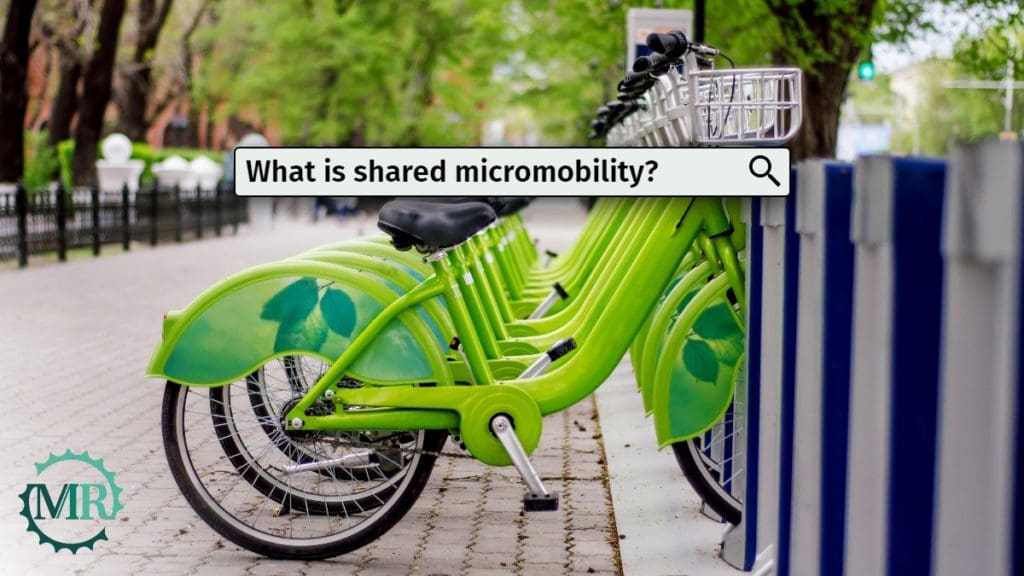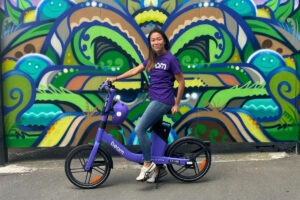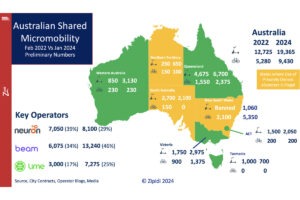What is Shared Micromobility?

Shared micromobility is any small, human or electric-powered transportation solution that is shared between multiple users.
Shared micromobility refers to bike share and scooter share schemes. Bike share came first, and scooter share is much more recent.
There were basic bike share schemes dating back to the 1970’s. But the systems only really took off in the early 2000’s when several technologies reached maturity. These included electronically controlled, internet-connected docking stations, credit card and other smart card payment systems, live GPS (global positioning system) tracking of the shared fleet and mobile phone apps giving real-time information about the location of bikes available for hire and empty docking station spaces for returning bikes.
The first modern bike share system started in Lyon, France. This was quickly overtaken by Paris, which has one of the largest bike share systems to this day. Other major systems in western cities include London and New York. But the largest systems of all are in Chinese cities. There are two websites that track the global bike sharing network in real-time, bikesharingworldmap.com and bikesharemap.com.
According to the Bike Sharing World Map as of 27th September 2021, there were 1,881 bike share schemes open and 266 more planned. Of the open schemes, 471 had 1,000 or more bikes in their fleet, of these 297 had 2,000 or more bikes, of these 188 had 4,000 or more bikes and of these 171 had 6,000 or more. The vast majority of these largest fleets are in China with six in Europe and five in North America.
“…e-bike and e-scooter share schemes continue to be launched in more cities, both within Australia and globally. Meanwhile, in cities where they’re well established, they’re being expanded and upgraded.”
Dockless Bike Share
Dockless bike share allows more flexibility, with the bikes not having to be hired from, or returned to a dock. These systems suffered from bad publicity when cheap Asian sourced systems flooded many cities, including in Australia and bikes were vandalised, dumped in rivers and so on.
Today most of these problems have been overcome with better technology and tighter ‘level of service’ contractual requirements imposed upon the share companies by the host cities.
e-Bike Share
Since the late 2010’s e-bike share systems have been taking over from conventional (non-electric bike) share systems. Even though the bikes are more expensive to supply and to hire, consumers have voted with their wallets and the hire rates per day for e-bike share bikes are much higher than for non-e-bikes. This is not surprising because both styles of share bikes are built to be ‘bulletproof’ and therefore are very heavy. At the slightest hill or incline, they become hard work to pedal, unless they have electric power assist.
In the 2020’s the rate of e-bike share growth has accelerated and is very likely to continue to do so until most share bikes, especially in wealthy cities, are of the e-bike variety.
e-Scooter Share
e-Scooter share schemes only really took off from 2018. These schemes have been dockless from day one. E-scooter share schemes are so popular that in the space of just two years, the total number of rides globally has overtaken what took bike-share schemes 20 years to accumulate.
Future Trends in Share Systems
E-bike and e-scooter share schemes continue to be launched in more cities, both within Australia and globally. Meanwhile, in cities where they’re well established, they’re being expanded and upgraded.
Both e-bike and e-scooter have their place and eventually, we predict that most cities will have both. E-scooters are most convenient in very tight spaces and for shorter distances. E-bikes are better for longer distances and where loads such as groceries or bags need to be carried.
Some of the major share scheme companies including Lime, Bird and Beam are now operating mixed fleets ie both e-scooters and e-bikes. In some cases, they’ve designed them to use identical batteries, so that they can most efficiently swap batteries when they’re servicing and rebalancing their fleets. Rebalancing is when bikes or scooters are moved from an area of lower demand to an area of higher demand. This is often done by workers picking them up in a delivery van or truck and dropping them off at the optimal locations.
Gradually city authorities are realising that bike and scooter share is not a novelty but an important part of the public transportation network. Over time this will lead to better integration and possibly even government funding. This is already happening in some of the more progressive parts of Europe.
Another feature already operational in some countries is the ability to use the existing public transport smart card to hire e-bikes and e-scooters, making a multi-mode transport journey simpler and easier for all customers.
Help us share the latest micromobility news with others…
Join us on social media
About the Micromobility Report
Every new activity needs a forum through which its new products and the latest trends can be shared and discussed. The Micromobility Report aims to be that forum, under the tag line, ‘Go Further With Less’.
Its content is arranged under four main menus:
- Products will cover every relevant form of bike, scooter and other LEV (light electric vehicle).
- Infrastructure will cover a wide range of topics including bike and scooter share systems, end of trip facilities, integration & data, planning, design & education, policy & funding, mobility as a service (MAAS) and more.
- Recreation will include all forms of micromobility tourism and recreation including rail trails and MTB parks.
- Features will include the latest companies and products, Annual Guides focused on key micromobility topics and opinion articles.
Want to stay in the loop with industry news and updates? The Micromobility Report has a free monthly newsletter to keep you informed. Subscribe Now!







